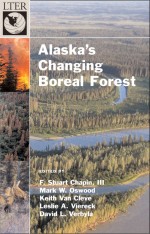By Chapin, F.S., III, M.W. Oswood, K. Van Cleve, L.A. Viereck, and D.L. Verbyla (editors). 2006. Oxford University Press, New York.
The boreal forest is the northernmost forested biome, whose organisms and dynamics have been shaped by cold high-latitude conditions. The Alaskan boreal forest is now warming as rapidly as any place on earth, providing an unprecedented opportunity to examine a biome as it adjusts to change. This book, based on Bonanza Creek LTER research, describes the processes that have shaped the development and current dynamics of Alaska’s boreal forest. This forest developed over the last 13,000 years in response to a gradually cooling, moistening climate, punctuated 6,000 years ago by an increase in wildfires when flammable black spruce ecosystems became widespread.
Permafrost (permanently frozen soil) is patchily distributed in the boreal forest. Where present, it impedes drainage, producing cold wet soils that constrain biogeochemical cycles and productivity. Landscape patterns of biogeochemistry are therefore strongly controlled by cycles of disturbance (flooding in lowlands and fire in uplands), with pulses of nitrogen input and loss in early succession shifting to tight plant-microbial recycling in later stages. Successional changes in abundance of a few key functional types (nitrogen-fixing alder, moose, and snowshoe hares in early succession; mycorrhizal fungi, mosses, spruce, and beetles in late succession) generate threshold changes in structure and function through succession.
Recent warming has increased drought stress in trees, frequency of wildfire and insect outbreaks, sporadic loss of permafrost, loss of nitrogen from nitrogen-limited watersheds, and changes in feedbacks to regional and global climate. Many of these changes have substantial societal importance, both regionally and globally, suggesting that continuing efforts to develop a predictive understanding of ecological resilience and change are critical.

 Enlarge this image
Enlarge this image